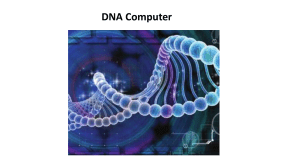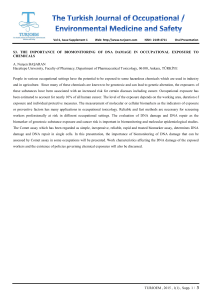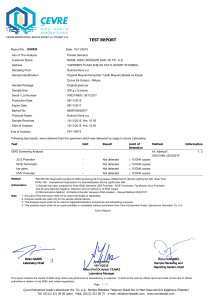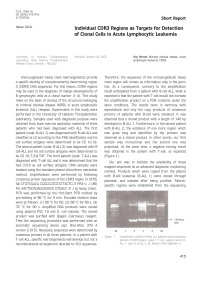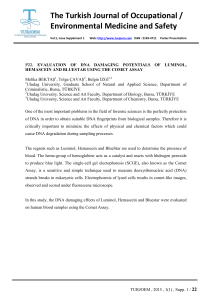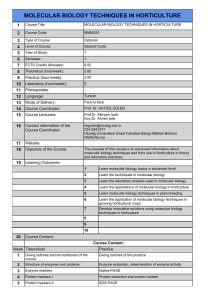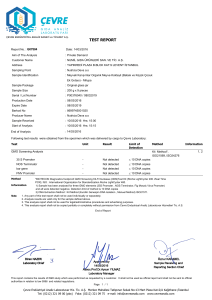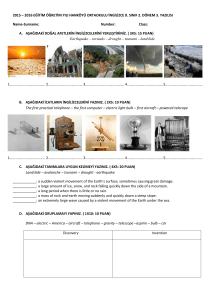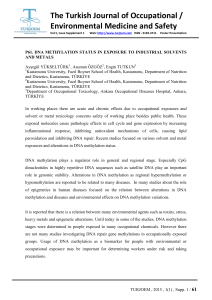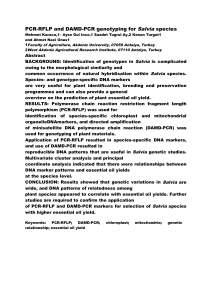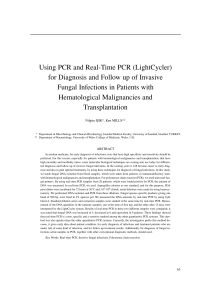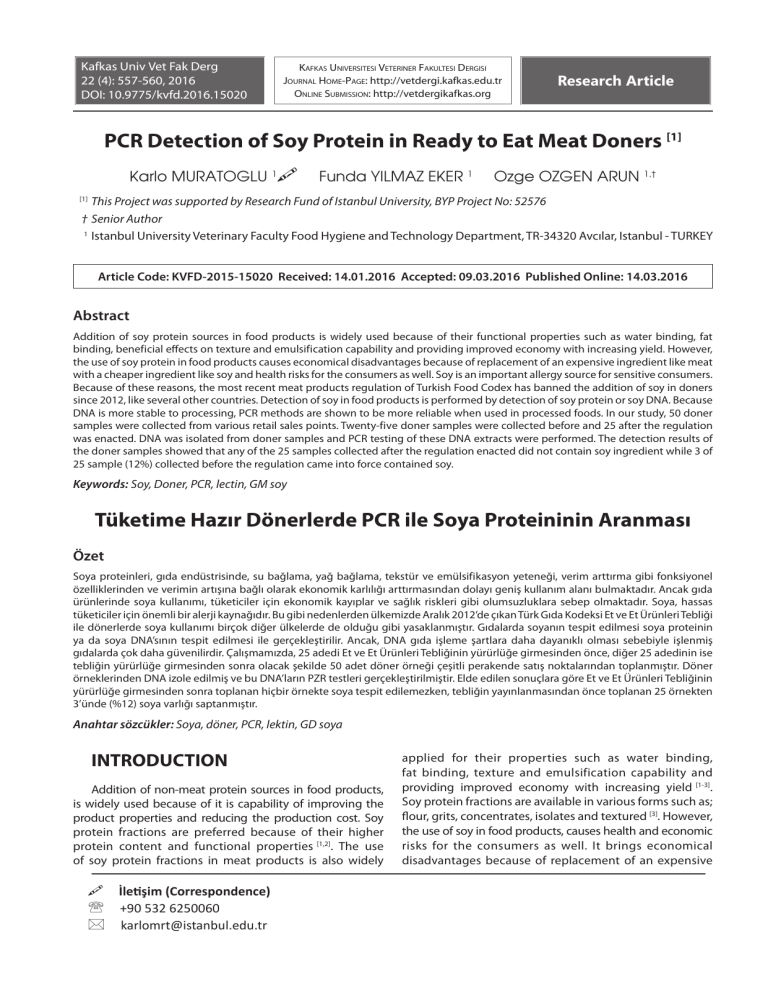
Kafkas Univ Vet Fak Derg
22 (4): 557-560, 2016
DOI: 10.9775/kvfd.2016.15020
Kafkas Universitesi Veteriner Fakultesi Dergisi
Journal Home-Page: http://vetdergi.kafkas.edu.tr
Online Submission: http://vetdergikafkas.org
Research Article
PCR Detection of Soy Protein in Ready to Eat Meat Doners [1]
Karlo MURATOGLU 1
Funda YILMAZ EKER 1
Ozge OZGEN ARUN 1,†
This Project was supported by Research Fund of Istanbul University, BYP Project No: 52576
† Senior Author
1
Istanbul University Veterinary Faculty Food Hygiene and Technology Department, TR-34320 Avcılar, Istanbul - TURKEY
[1]
Article Code: KVFD-2015-15020 Received: 14.01.2016 Accepted: 09.03.2016 Published Online: 14.03.2016
Abstract
Addition of soy protein sources in food products is widely used because of their functional properties such as water binding, fat
binding, beneficial effects on texture and emulsification capability and providing improved economy with increasing yield. However,
the use of soy protein in food products causes economical disadvantages because of replacement of an expensive ingredient like meat
with a cheaper ingredient like soy and health risks for the consumers as well. Soy is an important allergy source for sensitive consumers.
Because of these reasons, the most recent meat products regulation of Turkish Food Codex has banned the addition of soy in doners
since 2012, like several other countries. Detection of soy in food products is performed by detection of soy protein or soy DNA. Because
DNA is more stable to processing, PCR methods are shown to be more reliable when used in processed foods. In our study, 50 doner
samples were collected from various retail sales points. Twenty-five doner samples were collected before and 25 after the regulation
was enacted. DNA was isolated from doner samples and PCR testing of these DNA extracts were performed. The detection results of
the doner samples showed that any of the 25 samples collected after the regulation enacted did not contain soy ingredient while 3 of
25 sample (12%) collected before the regulation came into force contained soy.
Keywords: Soy, Doner, PCR, lectin, GM soy
Tüketime Hazır Dönerlerde PCR ile Soya Proteininin Aranması
Özet
Soya proteinleri, gıda endüstrisinde, su bağlama, yağ bağlama, tekstür ve emülsifikasyon yeteneği, verim arttırma gibi fonksiyonel
özelliklerinden ve verimin artışına bağlı olarak ekonomik karlılığı arttırmasından dolayı geniş kullanım alanı bulmaktadır. Ancak gıda
ürünlerinde soya kullanımı, tüketiciler için ekonomik kayıplar ve sağlık riskleri gibi olumsuzluklara sebep olmaktadır. Soya, hassas
tüketiciler için önemli bir alerji kaynağıdır. Bu gibi nedenlerden ülkemizde Aralık 2012’de çıkan Türk Gıda Kodeksi Et ve Et Ürünleri Tebliği
ile dönerlerde soya kullanımı birçok diğer ülkelerde de olduğu gibi yasaklanmıştır. Gıdalarda soyanın tespit edilmesi soya proteinin
ya da soya DNA’sının tespit edilmesi ile gerçekleştirilir. Ancak, DNA gıda işleme şartlara daha dayanıklı olması sebebiyle işlenmiş
gıdalarda çok daha güvenilirdir. Çalışmamızda, 25 adedi Et ve Et Ürünleri Tebliğinin yürürlüğe girmesinden önce, diğer 25 adedinin ise
tebliğin yürürlüğe girmesinden sonra olacak şekilde 50 adet döner örneği çeşitli perakende satış noktalarından toplanmıştır. Döner
örneklerinden DNA izole edilmiş ve bu DNA’ların PZR testleri gerçekleştirilmiştir. Elde edilen sonuçlara göre Et ve Et Ürünleri Tebliğinin
yürürlüğe girmesinden sonra toplanan hiçbir örnekte soya tespit edilemezken, tebliğin yayınlanmasından önce toplanan 25 örnekten
3’ünde (%12) soya varlığı saptanmıştır.
Anahtar sözcükler: Soya, döner, PCR, lektin, GD soya
INTRODUCTION
Addition of non-meat protein sources in food products,
is widely used because of it is capability of improving the
product properties and reducing the production cost. Soy
protein fractions are preferred because of their higher
protein content and functional properties [1,2]. The use
of soy protein fractions in meat products is also widely
İletişim (Correspondence)
+90 532 6250060
[email protected]
applied for their properties such as water binding,
fat binding, texture and emulsification capability and
providing improved economy with increasing yield [1-3].
Soy protein fractions are available in various forms such as;
flour, grits, concentrates, isolates and textured [3]. However,
the use of soy in food products, causes health and economic
risks for the consumers as well. It brings economical
disadvantages because of replacement of an expensive
558
PCR Detection of Soy ...
ingredient like meat with a cheaper ingredient like soy.
Besides soy is an important allergy source for sensitive
consumers [3-5]. Because of these reasons, use of soy in food
products are limited or banned in various countries [4,5].
In our country presence of soy in a food product has to
be declared in the label. Additionally, meat products
regulation of Turkish Food Codex banns the addition of
soy in doner [6]. Despite, addition of soy in ready to eat
meat products like doner, meat patties is not uncommon
for reducing the cost.
Several methods have been used for detection of soy in
food products so far [3,4,7]. However, most reliable methods
are based on detection of soy protein or DNA. Protein based
methods includes, electrophoretic or serologic (ELISA)
methods [7-9] while PCR is most widely used as DNA based
methods [4,10]. Because DNA is more stable to processing
conditions than protein, PCR methods are shown to be
more reliable when used in processed foods [10].
In this study, the presence of soy in doner kebabs sold in
local sales points were investigated. The doner samples
examined were purchased before and after the regulation
enacted, to evaluate the effect of regulatory enforcement.
For this, PCR detection of soy specific lectin gene with PCR
was performed. The positive samples were further analyzed
to detect whether they are Genetically Modified (GM) or not.
MATERIALS and METHODS
Doner Samples
For the study, 50 meat and poultry doner samples were
collected from various retail sales points. Twenty five of
these doner samples were collected before the regulation
was released, while 25 were collected after the regulation.
Additionally, soybean powder (IRMM, Geel, Belgium) and
beef were used as positive and negative controls respectively.
All the meat samples were stored in -20°C freezer till they
were used.
DNA Extraction and Purification
For DNA isolation from doner samples and positive
and negative control samples, the Promega WizardTM DNA
isolation kit (Promega, Madison, USA) was used according
to the manufacturer’s instructions. Two hundred to three
hundred milligrams of food material taken from a previously
homogenized sample was mixed with 860 µl of extraction
buffer (10 mM Tris-OH, 150 mM NaCl, 2 mM EDTA and
1% w/v sodium dodecyl sulfate), 100 µl of guanidine
hydrochloride (5M) and 40 µl of proteinase K (20 mg/ml),
then incubated at 65°C overnight. The samples were then
centrifuged at 13.500 g for 10 min. After centrifugation, 500
µl of the supernatant was mixed with 1 ml of WizardTM resin
(Promega, Madison, USA) and pushed through a WizardTM
minicolumn (Promega, Madison, USA). The column was
further washed with 2 ml of isopropanol. Following
centrifugation of the column at 12,000 g for 5 min, the
DNA was eluted with 50 µl of pre-warmed (65°C) elution
buffer (10 mM Tris-OH). The columns were incubated at
room temperature for 1 min and centrifuged at 10.000 g
for 2 min. The collected DNA was stored at -20°C until used.
DNA quantification was achieved by measuring the
UV absorption at 260 nm using a T80 UV/VIS spectrometer
(PG Ins. Ltd., UK).
PCR Primers and PCR Conditions
The primers GMO3 (5′-GCC CTC TAC TCC ACC CCC ATC
C-3′) and GMO (5′-GCC CAT CTG CAA GCC TTT TTG TG3′) were used for the amplification of soy-specific lectin
sequence and yielded a longer PCR product (118 bp) [10,11].
The primers 35s-f2 (5’-TGATGTGATATCTCCACTGACG-3’)
and petu-r1 (5’-TGTATCCCTTGAGCCATGTTGT-3’) were used
for the amplification of GM soy-specific Round Up Ready
(RUR) soy sequence and yielded a longer PCR product (172
bp) [11]. All PCR reactions were performed with a CG PalmCycler (CG 1-96 Genetix Biotech, Australia & Asia).
Amplification reactions for lectin contained; 5 µl of
genomic DNA and 20 µl of the appropriate PCR reaction
mixture. PCR reaction mixture consisted of 1X buffer
(Fermentas), 1.5 mM MgCl2 (Fermentas), 0.2 µM of each
primers, 0.8 mM of each dNTP (Fermentas) and 0.5 IU of
MaximaTM Hot Start Taq polymerase (Fermentas). The
amplification profile used for this mixture was as follow:
denaturation for 10 min at 95°C; amplification for 30 s at
95°C, for 30 s at 60°C, for 60 s at 72°C; number of cycles 35;
final extension for 3 min at 72°C.
For detection of GM soy, amplification reactions
which consisted of; 1X buffer (Fermentas), 1.5 mM
MgCl2 (Fermentas), 0.2 µM of each primer for RUR soy
amplifications, 0.8 mM of each dNTP (Fermentas) and 0.5
U of MaximaTM Hot Start Taq polymerase (Fermentas) were
used. The amplification profile used for this mixture was as
follow: denaturation for 10 min at 95°C; amplification for
30 s at 95°C, for 30 s at 60°C, for 25 s at 72°C; number
of cycles 40; final extension for 3 min at 72°C.
PCR products were electrophoresed through a 2%
agarose gel containing ethidium bromide. As a size
reference, a 50 bp DNA ladder (Fermentas) was used.
Visualization of the gels was performed with a UV transilluminator, and the gels were captured with the DolphinDOC system and Dolphin 1D Gel analyzing software
(Wealtec, Nevada,USA).
RESULTS
Total of fifty commercially sold ready to eat doner
samples which 25 of them were collected before the
related regulation came in to force while the rest 25
were collected after the enforcement were detected for
559
MURATOGLU, YILMAZ EKER
OZGEN ARUN
presence of soy protein with PCR in the present study.
For ensuring the reliability of the detection tests
appropriate quality control studies were performed
throughout the whole study.
PCR reaction which one of the extracts were spiked with
soybean powder DNA while the other were run without
spiking. The results showed that any of the 50 samples
did not contain any inhibitor.
For confirmation of the specificity of the primers PCR
tests were performed with DNA extracts obtained from
soybean powder and beef. The results showed that the
primers were specific to soy and did not give any false
result with the other main ingredient of doner like beef
(Fig. 1).
The detection results of the doner samples showed
that 3 of all 50 samples (6%) we analyzed were positive for
soy. Any of the 25 sample collected after the regulation
released, did not contain soy ingredient while 3 of 25
sample (12%) collected before the regulation came into
force contained soy. The gel electrophoresis results of
the positive samples are given at Fig. 2.
False positive results related to carry over contamination
during DNA sampling and extraction were avoided by
processing sterile milli Q water in parallel with the samples
at each step of extraction and PCR [12].
The lectin positive samples were further analyzed for
presence of GM soya. The results of this detection proved
that any of these samples contained soy from a GM source.
For elimination of false negative results related to
PCR inhibitors that might be present in the sample, DNA
extracts of each sample were run in triplicate for each
DISCUSSION
There is not much study performed on detection
Fig 1. Specificity of primers
Lane 1: DNA ladder, Lane 2-3: soy flour, Lane 4-5:
Beef, Lane 6-8: soybean powder, Lane 9: PCR mili q
water
Şekil 1. Primerların özgünlüğü
1. Sıra: DNA marker, 2-3. Sıra: Soya unu, 4-5. Sıra: Sığır
eti, 6-8. Sıra: Soya fasulyesi tozu, 9. Sıra: PCR mili q su
Fig 2. Agar gel electrophoresis of positive doner
samples
Lane-1: DNA ladder, Lane-2-3: doner sample-12,
Lane-4-5: doner sample-13, Lane 6-7: doner
sample-19, Lane 8-11: soybean powder Lane 12:
PCR milli q water
Şekil 2. Pozitif döner örneklerin agar jel elektroforezi
1. Sıra: DNA marker, 2-3. Sıra: 12. Döner örneği, 4-5.
Sıra: 13 Döner örneği, 6-7. Sıra: 19. Döner örneği,
8-11. Sıra: Soya unu, 12. Sıra: PCR milli q su
560
PCR Detection of Soy ...
on soy in meat products. The main reason of this issue is
that, it is not banned in several countries and it has been
banned in our country only in 2012. For this purpose, few
studies performed on detection of soy is mainly focused
on detection of GMOs [13,14]. Ulca et al.[13] detected the
presence of GM soy in various type of meat products and
the samples of this study were collected recently after the
regulation was released. According to these results, 32 out
of 38 total samples contained soy and 2 of these positive
samples were GM. In our previous study on detection of
GM soya in food products which we performed before
the regulation was enacted, we detected several meat
products containing soy ingredients. Because it was legal,
it was declared on the label as well [14]. However, different
than our results (6% in our study) all of the doner samples
Ulca et al.[13] analysed were positive for soy. According to the
Ct results of this study, the soy level of these doner samples
are quite low and most probably reflects trace amounts
of presence. Thus, this difference might be related to the
difference in the limit of detection of the two methods.
The possible disadvantage of too low detection limit
(below 0.1%) in authenticity testing is discussed by several
authors because of its effect on discriminating technical
unavoidable contamination and intentional addition [15,16].
For this purpose, it is not evaluated as a weakness of the
method used in our study.
Based on the results of our study, we can conclude that
intentional addition of soy was not commonly used in the
case of doner even before the regulation. The level of usage
has decreased after the regulation came in to force which
showed that the producers comply with the regulation
requirements. However, it is strongly recommended
to further monitor the other type of processed meat
products which are more commonly contained soy before
the regulation.
REFERENCES
1. Kurt Ş, Kılınççeker O: The effects of cereal and legume flours on the
quality characteristics of beef patties. Kafkas Univ Vet Fak Derg, 18, 725730, 2012. DOI: 10.9775/kvfd.2011.6013
2. Meyer R, Chardonnens F, Hübner P, Lüthy J: Polymerase chain
reaction (PCR) in the quality and safety assurance of food: detection soya
in processed meat products. Z Lebensm Unters For, 203, 339-344, 1996.
DOI: 10.1007/BF01231072
3. Belloque J, Garcia MC, Torre M, Marina ML: Analysis of soyabean
proteins in meat products: A review. Crit Rev Food Sci, 42, 507-532,
2002. DOI: 10.1080/20024091054238
4. Pedersen MH, Holzhauser T, Bisson C, Conti A, Jensen L B, Skov PS,
Poulsen LK: Soybean allergen detection methods - A comparison study.
Mol Nutr Food Res, 52, 1486-1496, 2008. DOI: 10.1002/mnfr.200700394
5. Poms RE, Klein CL, Anklam E: Methods for allergen analysis in
food: A review. Food Addit Contam, 21, 1-31, 2004. DOI: 10.1080/
02652030310001620423
6. Anonymous: T.C. Gıda Tarım ve Hayvancılık Bakanlığı, Türk Gıda
Kodeksi Et Ürünleri Tebliği, Resmi Gazete: 05.12.2012, No: 28488, 2012.
7. Mellenthin O, Galensa R: Analysis of polyphenols using capillary zone
electrophoresis and HPLC: detection of soy, lupin, and pea protein in meat
products. J Agr Food Chem, 47, 594-602, 1999. DOI: 10.1021/jf980749h
8. Hitchcock CH, Bailey FJ, Crimes AA, Dean DA, Davis PJ: Determination
of soya proteins in food using an enzyme‐linked immunosorbent assay
procedure. J Sci Food Agr, 32, 157-165, 1981. DOI: 10.1002/jsfa.2740320211
9. Hofmann K: Identification and determination of meat and foreign
proteins by means of dodecyl sulphate polyacrylamide gel electrophoresis.
Ann Nutr Aliment, 31 (2): 207-215, 1977.
10. Meyer R, Candrian U: PCR-based DNA analysis for the identification
and characterization of food components. Lebensm-Wiss u-Technol, 29,
1-9, 1996. DOI: 10.1006/fstl.1996.0001
11. Anonymous: EN ISO 21569: Foodstuffs - Methods of analysis for
the detection of genetically modified organisms and derived products
- Qualitative nucleic acid based methods (ISO 21569:2005). European
Committee for Standardization, Brussels, 2015.
12. Hübner P, Studer E, Häfliger D, Stadler M, Wolf C, Looser, M:
Detection of genetically modified organisms in food: critical points for
quality assurance. Accredit Qual Assur, 4, 292-298, 1999. DOI: 10.1007/
s007690050370
13. Ulca P, Balta H, Senyuva HZ: A survey of the use of soy in processed
Turkish meat products and detection of genetic modification. Food Addit
Contam B, 7, 261-266, 2014. DOI: 10.1080/19393210.2014.908960
14. Arun ÖÖ, Yılmaz F, Muratoğlu K: PCR detection of genetically
modified maize and soy in mildly and highly processed foods. Food
Control, 32, 525-531, 2013. DOI: 10.1016/j.foodcont.2013.01.023
15. Kesmen Z, Yetim H, Sahin F: Identification of different meat species
used in sucuk production by PCR assay. Gıda, 35 (2): 81-87, 2010.
16. Arun ÖÖ, Ciftcioglu G, Altunatmaz SS, Atalay S, Savasci M, Eken
HS: Effect of processing on PCR detection of animal species in meat
products. Kafkas Univ Vet Fak Derg, 20, 945-950, 2014. DOI: 10.9775/
kvfd.2014.11428

